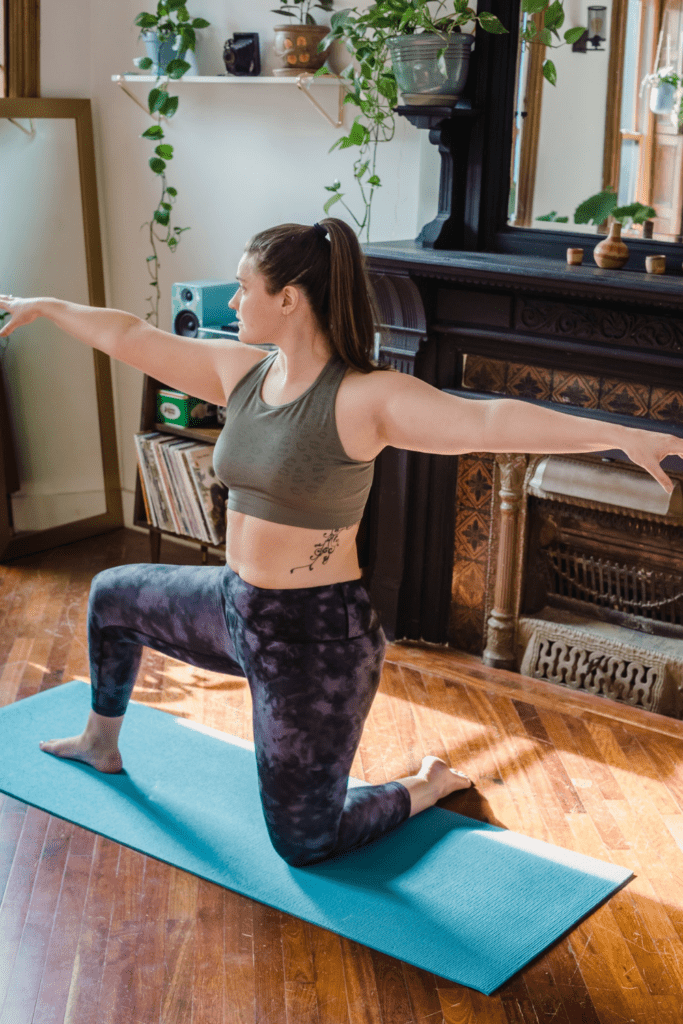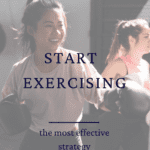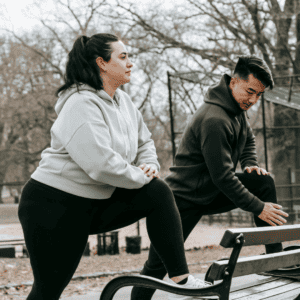How to start with exercise the smart way and stay motivated
Did you know that only 25% of adults get the recommended amount of exercise in their life? The sedentary nature of the pandemic we’ve experienced was a wake up call to many that it’s time to put some real effort into movement and exercise. It’s a huge part of staying healthy and moving well for a lifetime. If you’ve decided to start exercising, congratulations! This article covers how to start with exercise, especially after being sedentary for a while. Together, we’ll create your personal workout plan step by step.
Your Roadmap to Start Exercising Now
These may seem like simple steps, but I recommend taking your time and really thinking through each one. Make some pro/con lists, journal, or talk it through with a friend. The goal here is to create an exercise plan that’s sustainable, enjoyable, and fits your lifestyle!
How to start with exercise
Step 1: Find Your Why
Starting an exercise program because “well I guess I should” or “my doctor told me I had to” can be a recipe for failure. Before you even take a step or pick up a dumbbell, you need to figure out why you’re doing this. Your why can be big or small- anything goes here! It’s also okay if your “why” changes over time. Our lives change, and so do the reasons and the way we exercise. For now, choose just one to get started.
Here’s two ways to go about finding your why:
#1 - Set a Goal
Example: My goal is to run a 10k in eight months.
Having a goal or something to look forward to can make all the difference. You may already have something in mind, or you can find a goal that sounds interesting to you. When deciding on this goal, make it specific and measurable. For my 10k goal, I have the goal distance, and signing up for an event in eight months gives me a time frame for achieving my goal. Lastly, make your goal something you’re excited about!
#2 - Solve a Problem
Example: I get winded frequently while walking, and I want to work on that problem.
Your why can also be changing something about your life. Can you think of a problem that exercise will help you fix? Like setting a goal, you want to make it as specific as possible. How will you know when your problem is solved?
Step 2: What Do You Want to Do?
Now that you’ve established why you want to work out, it’s time to focus on the more practical pieces of creating a workout plan. The most important of these is deciding what you want to do for exercise!
Traditional Exercise
It’s popular because it works! If this is what you decide to base your personal workout plan on, there are a couple of different ways you can go about it. You might do only one of these, or mix them together in your program. Most exercise programs you can find or buy online combine all three of the following categories.
Weight training:
Includes dumbbells, kettlebells, gym machines, resistance bands, and barbells.
Cardio-based training:
Includes treadmills, ellipticals, stationary bikes, HIIT workouts, jogging, or anything else that will get your heart pumping.
Calisthenics/bodyweight exercise:
Includes push-ups, pull-ups, other bodyweight movements, and exercises that use boxes and balls

Photo by Andrew "Donovan" Valdivia on Unsplash
Feel like all the programs you find are too advanced? Read this article to learn how to fit your workout to your body.
Active Hobbies

Photo by Logan Weaver on Unsplash
Incorporating exercise and movement into your life doesn’t necessarily mean you have to do the typical cardio and weight training. Doing something you enjoy can be a great way to kickstart your exercise plan. This option works especially well if there’s an activity you’ve always wanted to try- now’s your time to go for it! You can start on your own, with a group of friends, or by finding a group or club that you can join.
Some examples of active hobbies are hiking, yoga, cycling, rock climbing, martial arts, swimming, dancing, and recreational sports.
Before you commit to this, make sure there’s a way you can do this activity near where you live or at home. For example, if you want to rock climb but the nearest climbing gym is 45 minutes away, it’s unlikely that you’ll go often. For any outdoor activity, you want to take the weather into account. If you live in a place that gets cold during the winter or very hot in the summer, will you still be able to exercise, or will you need a backup plan for those months?
Step 3: Where Do You Want to Work Out?
Going to a gym can help with accountability and providing equipment, but it’s not for everyone. Some people prefer working out at home without the commute. If you’ve tried one or both in the past, what did you like/dislike about it? Your choice in Step 2 may have already made this decision for you.
Do you want to work out at a gym or at home?
If you’re exercising at home, look into these options:
- Find an online program to follow.
- Take online group classes.
- Invest in a home workout system- treadmill, Peloton, Tempo, etc. (but make sure it doesn’t become a giant dust collector!)
- Hire a virtual or in-home personal trainer.

Photo by Tim Samuels on Pexels
When?
A huge part of determining where is figuring out your when. Signing up for a gym membership when you don’t have enough time during the week to use it can leave you feeling stressed out and unmotivated. Alternatively, when you’re working out at home it can be easy to “just do it later” …or never.
Try this activity:
- Using the weekly schedule download, map out your typical week.
- Use one color to fill in your current time commitments.
- Are there obvious chunks of time when you can exercise? If there are spaces in your schedule where you can fit workouts, use a different color to fill those in. Voila! There’s your workout schedule.
- If there aren’t obvious available spaces, it’s time to start getting creative! Are there places where you could fit in a 10-20 minute workout? What about short five-minute exercise breaks during your day?
Start small and build over time- you don’t have to cancel things you enjoy to fit in exercise, and you don’t have to start working out every day. The goal is to add exercise into your existing lifestyle (sustainable) instead of changing everything and cutting out things that make you happy (unsustainable).
Step 4: How Will You Stay Accountable?
The final part of how to start with exercise is creating a sustainable workout plan is that outlines how you’ll keep yourself accountable when you’re unmotivated. What happens in a few weeks when your motivation wanes?
- There are lots of habit tracking and accountability apps you can try. They use alerts, money motivation, or gamifying exercise to help you stay accountable.
- Get your friends into it! Ask if they’ll check in with you about workouts or maybe even join you.
- Have a rewards system. If you complete your exercising for the week, is there something small you can treat yourself to?
- Hire a personal trainer to help keep you accountable.
Now that we’ve gone through each step, it’s time to write out your personal workout plan and commit to living a healthier lifestyle! Remember, you don’t have to be perfect. Consistency is what counts- use your plan, and stick with it to see some amazing results!
Sarah Siertle, a strength and movement coach, specializes in introducing people to strength training and works to make the fitness world a more inclusive place. She has been a movement instructor since 2012 and also teaches swing dance around the US. Find other articles written by Sarah on her coach profile. Let Sarah help you get STRONG so you can take advantage of life’s adventures!







